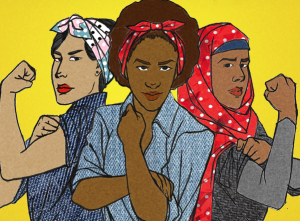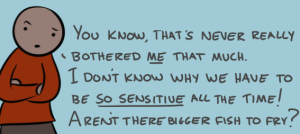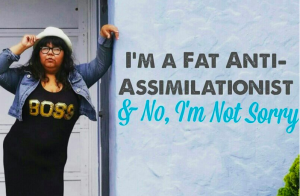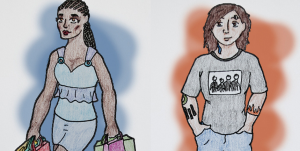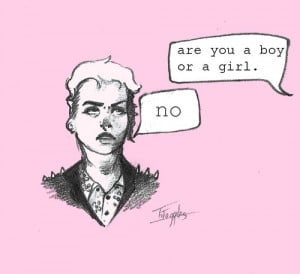Originally published in two parts at Skepchick and Queereka and cross-posted here with permission.
Disclaimer: I’ve chosen to focus this article on trans women only for the sake of brevity and clarity. It is not my intent to contribute to the ongoing cultural erasure of trans men, and I believe their voices, experiences and identities deserve to be heard and understood. Cis readers, please note that much of this can be applied to transsexuality in general.
 Debunking myths is one of those things that us skeptics are supposed to do, right?
Debunking myths is one of those things that us skeptics are supposed to do, right?
Okay then…
(my triskaidekaphilia isn’t showing, is it?)
Myth 1. Trans women are just really, really, REALLY gay.
This one is impressively persistent, and unbelievably common. It was even pulled out recently while Lance Bass, an openly gay man, was guest-hosting Access Hollywood.
The truth is fairly simple: gender identity and sexual orientation have nothing whatsoever to do with one another. A fairly common adage used to address this misunderstanding is “sexual orientation is about who you want to go to bed with, gender identity is about who you want to go to bed as.”
My own preference in addressing it is to simply point out the existence of trans lesbians (that is, trans women who are attracted to other women). Problem solved. Let’s go have tea and scones.
Or so one would hope, anyway.
I think a lot of this confusion stems from how strongly we associate behaviour with gender. The cultural assumption of heterosexuality is so intrinsic, we see gay men as being somehow in defiance of what it is to be a man. They become regarded as female-like or transgender simply by engaging in a mode of sexuality that is more common amongst women than men, even though many gay men express themselves in an almost hyper-masculine way.
This misconception is amplified by our overemphasis of sex and sexuality when thinking about gender and what gender means, so we can end up regarding any expression of gender as being about sexuality. Such as the widespread assumption by men that women dress nice or stylishly or sexily primarily as a means of attracting men, rather than simply an expression of their own identity and feelings that day.
This myth is damaging to both trans women and gay men alike. It also often leads to trans issues being swept aside or subsumed within broader discussions of LGBTQ stuff.
Such as how this ad that ran in the Canadian newspaper The National Post was largely decried for being homophobic rather than transphobic despite being almost entirely based around promoting fear of transgenderism, and how the narrative of PFC Manning has been written as the story of a gay man in the military, despite the fact that the evidence clearly shows she had been planning to transition immediately upon return to civilian life. She continues to be described even by her supporters in male and masculine terms.
Short answer: sex / gender and sexuality do not have a deterministic relationship to one another. Which is why there are such things as gay, lesbian and bisexual people in the first place.
Myth 2. So you’re going to get your penis cut off?
Another impressively common one.
In short, no. That’s not how it works.
I hope I don’t squick you all out too much, but I’ll provide a really rough, basic explanation of one of the common forms of MtF lower surgery (aka SRS, sexual reassignment surgery, aka GRS, genital reconstruction surgery, aka vaginoplasty), using the “inversion method”.
The penis is basically split into three pieces. The tip is sort of detached from the bulk of the shaft to be formed into a clitoris. The skin of the shaft is removed and the shaft itself split down the middle. It is then inverted into a vaginal canal such that the exterior circumference of the shaft serves as the vaginal lining. This preserves sensation in the event of penetrative sex as well as allows for a certain degree of natural lubrication during arousal. The testes are indeed discarded but they’re pretty much the only bit of tissue that doesn’t get used. The scrotal tissue is used to form outer labia and create the aesthetic appearance of a typical female vulva. Remaining tissue and skin get used to form a clitoral hood and add additional depth to the vaginal canal as needed.
The procedure is remarkably effective, and has come quite a long way over the decades. Trans women today are able to preserve considerable sensation (often no loss of sensation reported at all), and very many report greatly improved sexual satisfaction and full orgasmic potential. The outward appearance is virtually indistinguishable from any other woman’s vulva. The only two things that are typically at all noticeable are that if your partner is particularly well-endowed, he may notice a slight lack of depth, and the vaginal canal is often a little bit steeper than in cis women, though that can be prevented by a trans woman taking care to exercise proper technique while dilating (a process required to ensure the vaginal canal doesn’t close).
There are a few things that I find particularly troubling about this misconception, or even just casual joking reference to “cutting off your dick”. One is reinforcement of the classic misogynist myth that women are incomplete men. Women are men, minus a few pieces. Female genitals are just the absence of male genitals. Castration anxiety, penis envy, blah blah blah, etc.
Clearly, that is not true. Women are their own sex, not simply lesser men. So why should we assume that acquiring girl bits is as simple as lopping off the boy bits and carving a gash?
The other problem is how it reinforces an image of trans women as sexless, mutilated Barbie dolls. It reinforces the idea that we have simply discarded our sex rather than creating for ourselves a new one. It is reductive, and imagines our new state as “less” than our previous one. It reinforces the sense that we’ve rendered ourselves inferior in sacrificing our maleness.
The reality is that transition is not a de-sexing of the body, it is a re-sexing of the body. Our genitals are not discarded, they are simply reshaped.
Myth 3. So you’ve chosen to get a sex change operation?
SRS is not what changes our sex. That’s only one tiny piece of the puzzle. And many trans women choose not to, or can’t, undergo SRS. A woman is not defined by what’s between her legs.
I lay this one at the feet of the media.
Unless a film or TV show is explicitly about the long, gradual, complex, multifaceted, emotionally harrowing, highly individual process of transition, it is impossible to really portray it accurately or fit it into a plot. Most of the times transition shows up in movies or TV, it’s as a plot device. Why waste time portraying something so complex and gradual when it’s just a little hinge in your narrative?
We’ve all seen it a million times. Bob goes into the hospital as a big, burly, manly dudely dude. Out walks Roberta in her heels and mini-skirt, with her D-cup breasts suddenly magically having appeared out of nowhere, her hair miraculously 12 inches longer, and goes swishing off to sleep with the first unsuspecting guy she can find.
No recovery time! No pain! No blood! No dilation! No bandages and packing! No long, tedious four year process for hormones to do their breast development, skin tone, body hair, fat redistribution thing. No irritating legal hassles with changing name and documentation. No emotional roller-coaster. No spontaneous bursts of tears. No voice training. No re-learning your body language and mannerisms. No anxiety about passing. No joyful revelation the first time you realize you are passing. No crying with happiness the first time you discover you can look in a mirror without hating what you see. No dealing with the scariness and awkwardness of beginning to date again. No re-learning the entire language of fashion and how to dress. No getting accustomed to bras and heels and earrings and annoying nightmarishly fiddly little jewelry clasps. No wondering whether the better orgasms are worth their infrequency. No rediscovering your sexuality. No long, complex process of reacquainting yourself with new genitalia and learning to understand them. No learning what you are and aren’t comfortable wearing. No getting nail polish all over your fingers and eyeliner in your eyeball because you never got a chance to learn how to do that stuff as a little girl. No coming out. No losing friends. No being disowned by family. No growing closer to the people who supported you. No adapting to the loss of male privilege and learning how to deal with cat calls. No nothing.
Basically? No transition. None of any of the stuff that makes it such an intense and incredible and traumatic and rewarding and beautiful experience.
And she’s wearing a mini-skirt! After SRS! Which in real life basically amounts to your entire lifetime’s worth of periods condensed into a two month period of recovery. Bloody, hormonal, moody, painful recovery.
And she goes and gets laid, too.
Trivializing? Kinda.
Myth 4. “It’s a trap” / Trans women are just gay guys trying to attract straight dudes.
See above about us not being gay guys.
But this one goes a lot deeper, a lot nastier, a lot more demeaning, and a lot more dangerous.
Dangerous in that a great many trans women have lost their lives to sexual partners who felt they were “tricked”.
The concept of “deception” is a tricky one, and it can be very complicated to unpack the various ethical dimensions of disclosure and where a trans person’s responsibility lies in terms of informing her partner.
That’s far too big a subject to tackle here, but Zinnia Jones provides a fantastic explanation in this YouTube video. I’d just like to say that I really don’t think it’s our responsibility to give you the opportunity to inflict your bigotry and hang-ups on us; it’s your responsibility to ask (if it’s that big a deal to you).
And if a woman was attractive to you one moment and a repulsive, lying whore the next, when all that has changed is that you now know a largely irrelevant detail of her history, the problem is with your perceptions, not her body.
The problematic implications of us being “traps” are a bit too numerous to name them all. A few that come to mind are the basic assumption that we’re “really” men, believing that our decisions all revolve around you andwe’re doing this for your sake, not our own (kind of like the earlier example about how men may interpret how a woman dresses), the issues of conflating gender expression with sexual motivations, the concept that femaleness and femininity are artifice and fake, etc.
But I guess the one that I’d most like to unpack is how, like the thoroughly debunked theory of “autogynophilia”, it looks at trans women’s sexuality and motives through a lens of male sexuality and motives.
A hypothetical cis male sits on his couch and is absent-mindedly flipping through a porn magazine. He comes across an ad for “shemale” porn. He wonders, “why would anyone ever do that? Why would a man want to become a woman? That’s crazy!” (yeah, let’s put aside the implicit misogyny there… we can talk about that some other time) and rather than think about it in terms of why a woman would want a female body and not a male one, he thinks about it in terms of why a man would want a female body.
The conclusions he draws, based upon the assumption that a man is fundamentally a sexual agent and a woman is fundamentally a sexual object, are that the “shemale” is doing it to get laid, to attract men to him with his new hot, curvy, sexual-object of a body. Either that or, as in “autogynophilia”, doing it to have himself as his very own personal sex object.
Never mind what happens to a trans woman’s libido during HRT. Never mind that for very many trans women, that period of time, exactly when the libido starts diminishing, happens to be when commitment often deepens, and any remaining doubts and questions are resolved.
Forget that. It MUST be about sex. Because that’s all the female body is good for: sex.
Right?
Myth 5. Aren’t you sort of reinforcing stereotypical gender roles?
Aren’t you just going along with the idea that having a feminine personality means you must be female? Doesn’t that perpetuate the idea that there are certain ways women and men are “supposed” to be like?
Much like the existence of trans lesbians serves to disprove the “really, really gay” myth, in this case we can point to the existence of butch or tomboy trans women. Ta da! Myth vanishes in a puff of logic. But to explain further…
This is about a very basic confusion: lack of understanding the difference between gender identity and gender expression.
Gender identity is an internal sense of self and what one fundamentally is. It’s the sense of being a man or a woman (or both, or neither, or in-between, or something else). It is divorced from concepts of what a man or woman is or isn’t supposed to be like, and appears to be very much innate and unchanging. It also appears to be related to the neurological “body map” and relationship to one’s body- feelings of either comfort or alienation.
Gender expression is the degree to which one’s personality, interests and manner of self-expression is culturally regarded as “masculine” or “feminine” (or “androgynous”). This is heavily culturally and socially mediated. What is regarded as feminine in one culture may be regarded as masculine in another. There seem to be some gendered traits that are in varying degrees innate to an individual but gender expression is an aggregation of many, many, many such traits which can occur in an immense variety of combinations.
An imperfect but very helpful breakdown from the Center For Gender Sanity (which I think I’ve used before, actually) can be found here.
What makes a person transsexual, and motivates one to pursue physical transition, is typically a conflict of gender identity with physical, assigned sex. It is not a conflict of gender expression or role with physical, assigned sex.
We transition not because we feel we’re too feminine to be men, or that the presence of feminine characteristics means we must be female. The motivation is far deeper and far less analytical than that.
We transition simply because we know ourselves to be female… totally independently of how well we do or do not fit into female stereotypes.
Hence we are not simply basing this off of an overly strict concept of gender roles where we need to get our bodies to conform to a socially mandated binary.
We are only seeking to get our bodies to conform to our sense of self so that we can feel that they are our own rather than a creepy gross alien thingy that happens to be attached to us. And our existence does not in any way support, perpetuate or rely upon those binaries… we are fundamentally transgressing them and asserting that they may be broken, and sometimesmust.
Myth 6. If our culture didn’t have such strict gender roles, there would be no need for transition.
This is another mistake stemming from the confusion of gender identity with gender expression, and also again the belief that a trans woman makes her decision because she is uncomfortable with the male gender role rather than the male body.
The argument runs that, basically, if we were to break down the socially arbitrated binary and “gender straitjacket” we would no longer feel any sense of conflict between our selves and our assigned sex.
But, again, we do not transition out of discomfort with the male gender role. We transition out of discomfort with the male body.
No matter how open, enlightened and non-gendered our society could be, most women would go right on feeling just as alienated and disturbed by having a penis, a pair of testicles pumping her full of testosterone, a hairy face and body, a masculine distribution of muscle and fat, a flat chest, that acidic male locker room smell, ruddy oily skin, etc.
And most men would go right on feeling creeped out and appalled by having a vagina, menstruating every month, having breasts, soft and smooth skin, no beard, a feminine shape, wide hips, the rising and falling cycle of estrogen and progesterone, etc.
Transsexuality is first and foremost about us and our bodies and our right to be happy within them, not all about social conventions or the politics of gender or what you think society should be or what you think is best for us.
People whose gender identity is in conflict with their physiological sex will continue to exist no matter how well we accommodate for variation in gender expression. Solving society’s problems of gender won’t solve all the problems of sex.
Please, take it as a reasonable assumption that we’ve thought this stuff through, our decisions are our own, and we haven’t just been duped by the patriarchy or whatever.
It sucks to have people who are ostensibly your allies tell you you’re living your life wrong and that the biggest, most important, most difficult, most thought-through decision you ever made was just a result of being brainwashed by the system, maannnn.
Myth 7. You’re so brave!
No. That’s a lovely idea, it is, and thank you. I do appreciate the sentiment and we often enjoy hearing that kind of thing. It’s an enormously tempting idea, too, and hard to give up. It would be terrific to believe that I’m this wonderfully brave, courageous, strong woman who overcame unimaginable odds to assert her true self without compromise to a hostile, bigoted world.
But it just isn’t true. We aren’t brave. We’re scared shitless and in tremendous pain and desperate for a way out, and don’t really have much of a choice.
Imagine you’re being chased by a pack of snarling wolves through a darkened, stormy forest. They’re nipping at your heels, just behind, barking and growling with long strings of saliva dangling from their bared fangs. Your body is aching and sore and straining against the exhaustion, just barely maintaining your sprint through a combination of adrenaline and the terrifying certainty of death should you give in.
Somewhere in the darkness and gloom you suddenly catch a glimpse of light. You run towards it, screaming for help as best you can through your bursting, panting lungs. It is a cabin. You finally make it to the door, you throw it open, and just in nick of time as one of the wolves lunges for your throat, you slam the door shut behind you. At last you’ve escaped. You’re safe.
Inside the cabin sits a friendly old man smoking a pipe and mulling some wine. As you stand there, shaking and gasping for breath and crying and terrified out of your wits, he smiles and says, “wow, you’re really brave.”
Some of us are brave. Some of us are strong. But that’s not always the case, and can’t necessarily be inferred from our transition. We do what we have to do, however we can, no matter how scared we are.
But on the other hand, as it was articulated in Black Swan Green by David Mitchell, one of my favorite novels:
“Courage is being scared shitless and doing it anyway.”
Myth 8. You’re appropriating the female body.
Appropriation is about co-opting someone else’s identity. We’re not doing that. We’re expressing our identity.
It is not an act of attempting to emulate or express ourselves as The Other, we are attempting to more accurately and honestly express The Self. We don’t transition into being a new or different person. We become more ourselves. We don’t put on a mask, we take one off. We don’t another cliché metaphor, we just cliché metaphor.
It is not YOUR body or sex that is being in any way appropriated or affected. We are making decisions about our own bodies, our own sex, specifically just trying to feel at home within them…. Which is our choice to make. Our bodies, our choices, yeah?
Myth 9. Why can’t you just accept yourself? Why not just learn to be comfortable with who you are?
This one is usually based on analogy to cosmetic surgery and eating disorders.
After all, we do teach people to do their best to accept their bodies and not treat themselves with loathing. We rightly teach people that self-acceptance is of great importance to one’s mental and emotional well-being.
The appropriate response to body-image issues is therapy, and to reinforce self-acceptance, not to facilitate an obsession with cosmetic surgery or enable an eating disorder.
But gender dysphoria is not as simple as a “body-image issue”, and has been proven unresponsive to therapy and psychotropic medication. There are certain reasonable expectations a person can have for their body, and there are certain conflicts between body map or self image and physical configuration of the body that deserve to be addressed through medical means.
Consider, for instance, the case of skin grafts for a burn victim, plastic surgery for someone with an extreme socially and psychologically debilitating deformity, or prosthesis for an amputee. In these cases, we don’t simply teach self-acceptance.
That is part of the process, sure (as it is with gender transition), but we do provide medical intervention and don’t question or belittle their desire for it. They are only asking for a relatively basic level of bodily integrity. That line is subjective but it is present.
If you’re cisgender, ask yourself: were your genitals to be lost or disfigured in an accident, would you want someone to chastise you for wanting a prosthesis or cosmetic surgery? A body consistent with one’s internal conception of sex and gender is a perfectly reasonable thing to want and a very difficult thing to live without.
Furthermore, these kinds of procedures, and gender transition, have specific, defined end-points and goals. Eating disorders and cosmetic surgery do not. Someone with a severe psychological body-image disorder will, presumably, never feel pretty or thin enough. They will remain unhappy, and the physical changes won’t solve the underlying issue.
In the case of gender transition, and cosmetic procedures for burns and deformities, there is an end-point and the procedures consistently produce a great deal of psychological and emotional benefit with significant improvements in the patient’s well-being.
Most medical procedures are not simply about sustaining life. They are about maintaining well-being and improving quality of life. That is what transition provides… a quality of life an individual may reasonably expect.
No other procedure or treatment has ever been proven effective or helpful in addressing the extreme detriment to mental health caused by Gender Identity Disorder.
Myth 10. You don’t really become female. The process is only cosmetic. You’re still technically a man.
I addressed much of this a few weeks ago in this article. It has chickens!
To summarize: there is no particularly valid reason to prioritize the genetic definition of sex above all other aspects of physical sex: hormones, secondary sexual characteristics, genital configuration, etc. Chromosomes actually don’t play nearly as much of a role in human sexual differentiation as we often think they do. The Y chromosome is mostly deteriorating junk DNA that’s only real function is to turn the gonads into testes. In an XX cell, one of the X chromosomes is deactivated.
As such, there’s no real functional difference between a “female” cell and a “male” cell. The process of sexual differentiation in humans is not genetic in nature, but hormonal.
As for the matter of being “cosmetically” female… a trans woman’s secondary sexual characteristics are in no substantial way different from that of a cis woman and are formed through the exact same physical processes. If my breasts are to be deemed “cosmetic”, so too must the breasts of any woman at all.
There is no single variable we can point to that suggests someone is “really” female or not. Doing so for any individual trait will necessarily require excluding some cis women from the category. There are some traits that no trans woman possesses, but there will always be cis women who don’t possess those traits either.
As such, there is no definitive way that you can suggest trans women are outside of the category “woman” but all cis women are in. At least not without going into tautologies like “only cis women are really women because trans women aren’t really women”.
In so far as the term “woman” is to be at all meaningful and consistent, trans women must be included.
Myth 11. Drag queens, transsexuals, transgenders, cross-dressers, what’s the difference?
First, don’t say “transgenders”. Nouning-the-adjective places the category above the person. Say “transgender women/men/people”.
Transgender is an umbrella term that includes all significant deviation from the norms of gender and sex. Drag queens, transsexual people, cross-dressers, transvestic fetishists, people who identity as trans-masculine or trans-feminine, people who are genderqueer, etc. are all included.
Transsexual refers specifically to people who permanently transition from one sex to another, usually through one or more medical treatments such as hormone replacement therapy and/or genital reconstruction surgery, usually along with legal and social changes such as change of legal name and documentation, alternate gender presentation (clothing, make-up, etc.), voice training and so on.
The adjective “trans”, as in “trans woman”, usually means transsexual but sometimes means transgender. It’s usually clear from context. This article, for instance, has been about transsexual women.
Drag queens are men (typically but not always gay) who dress in an exaggeratedly, campily female way for the sake of performance or entertainment. There is typically very little emphasis placed on actually passing as female but instead on having a particularly ostentatious and fun outfit. This is an act of playing with gender roles, not an act based on expression of a deeper internal sense of self. A drag queen adopts a female persona but will (almost always) have a male gender identity.
Cross-dressers are men with a male gender identity who, for a variety of possible reasons, choose to occasionally dress in women’s clothing and accessories and present as female. The acts of cross-sex presentation are temporary and do not reflect their “true self”.
A transvestic fetishist is a cross-dresser who does so for sexual motivations, due to being aroused or getting an erotic thrill from the cross-sex presentation. They also maintain a male gender identity and the cross-sex presentation is temporary.
These distinctions are important. Seriously.
Myth 12. Transsexuality is just an invention of the modern medical establishment, a symptom of Western culture.
Hormone replacement therapy and genital reconstruction surgery are modern medical treatments developed to address and accommodate a long-standing human issue.
Gender variance, although it may vary in its particular iteration, will not always be socially accepted or accommodated, and is sometimes only accommodated in very specific ways, occurs in pretty much all cultures and societies throughout human history.
Many cultures were actually fairly accepting and tolerant. Some even imagined transgendered identities to be especially blessed, lucky or powerful… such as a shamanic role for certain North American First Nations “two spirit” identities, the Galli priestesses of Cybele in ancient Greece, the paradoxically respected-and-stigmatized social status of Kathoey in Thailand, the positive social standing of Hjira in India prior to British colonial rule (which brought with it British attitudes towards gender variance), etc.
Gender variance has existed as long as human beings have. Transsexuality is simply a relatively new option for addressing it and meeting the needs of people with a sense of strong disharmony between gender identity and physical sex.
It didn’t create us, it is just a means of allowing us to live full, happy, meaningful lives and feel comfortable and at home in our bodies.
Myth 13. You’re infiltrating women’s spaces and making them unsafe.

First of all, we are women. So there’s that.
I’m not sure why whatever discomfort may arise from a cis woman’s hang-ups about the thought of a trans woman in the same bathroom or changing room or whatever, and the perceived risk, should take precedence over the extreme discomfort and actual physical risk that a trans woman would be forced to endure in using men’s facilities.
An argument I’ve encountered repeatedly is “well what’s to stop some male rapist or child molester or voyeur from putting on some lipstick, claiming to be transgender, and then sexually assaulting your daughters!” (Ominous scary organ chord!).
Well… there has never, ever been such an incident. No man has ever disguised himself as transgender for the sake of perpetrating such a crime.
And if what you are worried about is sexual assault and voyeurism then those are the issues you should be targeting, enacting policies against, and the people whom you should be demonizing.
Don’t demonize and punish innocent trans people over some wild, imagined hypothetical.
Would you ban lesbians from women’s facilities on the possibility of their voyeurism? No, probably not, and it’s extremely statistically unlikely for lesbians to commit sexual assault in such a setting.
But… it’s just as unlikely for trans women to do so. And remember that stuff about our libidos? Our difficulty achieving erection if we even have a penis?
If prevention of sexual assault is something you’re keenly interested in, then please start by focusing on dismantling a misogynistic culture that objectifies and devalues women and places their humanity as secondary to their bodies.
There is also a lot of anger and controversy within the feminist community about other types of women’s spaces. A particularly prominent example is the Michigan Womyn’s Music Festival, which enforces a trans-exclusionist “Womyn-Born-Womyn” policy (though they allow trans men to attend and perform).
Many of the justifications are parallel to those of the Christian right in forbidding us access to women’s bathrooms and changing rooms: we’re really men, it makes the environment unsafe (again, there is absolutely no data whatsoever to support this), what’s to stop men from attending under the pretense of being trans, etc.
But there are additionally complex issues. One is the general transphobic attitudes within certain branches of feminism (particularly radical feminism)…. The notion that we’re enforcing the gender binary (which relates to the “why can’t you just accept yourselves” thing and the confusion of gender identity with gender expression), the weird hypocritically gender-essentialist insistence that although gender is “just a social construct” we are nonetheless completely bound to our assigned sex and may not transcend it, many bio-essentialist claims (such as, literally: “rape is encoded on the Y chromosome”… I’ve actually come across that claim), etc.
It is also sometimes insisted that because we lacked female childhoods and the concomitant gender-socialization that we can’t possibly understand the female experience. That’s true in a sense… there are many aspects of a female life I did not experience and some I never shall.
But this is true of every woman. There is no universal, unwavering female narrative that everyone experiences exactly alike. There are as many stories as there are women. To act like any particular thing being absent means someone isn’t “really” a woman and can’t understand womanhood would necessarily mean excluding a whole lot of cis women, too.
All of these notions seem to be acts of bending over backwards and performing intellectual acrobatics to try to disguise their transphobia as being somehow an extension of their feminism when it in fact runs directly contrary to several of the fundamental tenets of feminism… that our lives, choices, identities and what we do with our bodies should not be dictated by external forces or forced upon us to conform with what society tells us those with our particular anatomy are supposed to be.
Biology is not destiny. Remember?
…
In summary, almost all of these misconceptions stem from the assumption that we’re really men, and considering us, our lives, our implications and our choices through a male frame of reference. A woman who is attracted to men is not gay. The existence of a woman as a woman does not reinforce traditional gender roles, nor would the breakdown of those roles cause her to disappear. A woman would not be asked to simply accept a male body. A woman would not be accused of appropriating womanhood, or infiltrating women’s spaces. A woman’s body, and the aspects of it that render it female, are not simply cosmetic.
If there is one myth to debunk from which all others would perish, it’s the notion that our gender is not legitimate. We are women. Just think of us as such, and you’ll get it.
…
ETA: When I said that a cross-dresser’s acts of cross-sex presentation do not reflect their “true self”, I should have been more clear: in the case of a CD (as opposed to a trans woman in denial who simply believes herself to be CD), the female presentation / persona isn’t MORE true than the male identity. Both are aspects of that individual’s sense of self. But the primary difference between a genuine CD and a trans woman is that the male identity is not held to be false while the female identity is held to be genuine. Instead, the male identity is still the primary expression of self that is inevitably returned to.
[do_widget id=‘text-101′]
Natalie Reed is a trans-feminist grrl blogger, queer, recovering addict, […]-survivor, etc. She got her start blogging at Skepchick, and now writes for Freethought Blogs. Her many ridiculous interests include linguistics, feminism, trans-feminism, anarchism, gender theory, queer theory, poetry, neuroscience, biology, Doctor Who, comic books, cartoons, shoegazing and punk rock. She was born with a Y chromosome but totally kicked its ass. Follow her on Twitter @nataliereed84.
Search our 3000+ articles!
Read our articles about:
Our online racial justice training
Used by hundreds of universities, non-profits, and businesses.
Click to learn more








